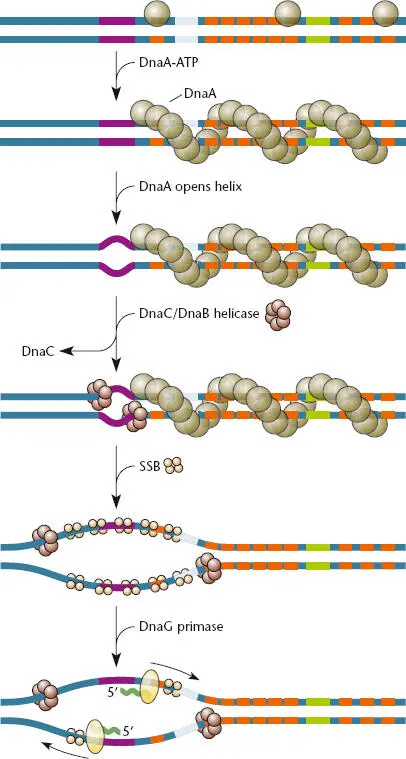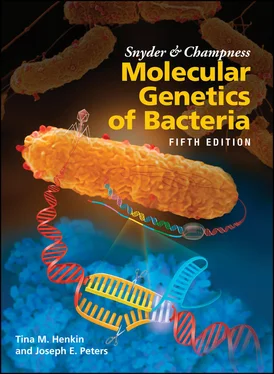Two types of functions are involved in the initiation of chromosome replication. One consists of the sites or sequences on DNA at which proteins act to initiate replication. These are called cis-acting sites. The prefix cis means “on this side of,” and these sites act only on the same DNA. The proteins involved in initiation of replication are examples of trans-acting functions. The prefix trans means “on the other side of,” and these functions can act on any DNA in the same cell, not just the DNA from which they were made. The concepts of cis - and trans -acting properties are common in molecular genetics, and these references are used throughout this book.
ORIGIN OF CHROMOSOMAL REPLICATION
One cis -acting site involved in DNA replication is the oriC site, at which replication initiates. The sequence of oriC is well defined in E. coli , and the basic components that make up oriC are broadly similar in most bacteria. Figure 1.14shows the structure of the origin of replication of E. coli . Less than 260 base pairs (bp) of DNA is required for initiation at this site. Within oriC are a series of binding sites for various proteins; the most important of these binding proteins is the master initiator protein in bacteria, called DnaA (see below). The canonicalDnaAbinding sequences are 9 bp in length, and these sites are termed DnaA boxes. While five DnaA boxes exist within oriC , three of these sites bind DnaA particularly strongly, i.e., are of particularly high affinity, and are always bound by DnaA ( Figure 1.14). The ability of DnaA to bind these high-affinity sites at all times can be considered analogous to the origin recognition complex associated with eukaryotes. Additional sites called “I” and “τ” sites, which differ from DnaA boxes, exist in the origin region but are occupied only by DnaA that is bound to ATP and not ADP (see below) ( Figure 1.14). Finally, within an ATrich region of DNA that is opened for initiation, called the DNA-unwinding element, are three additional sites for DnaA binding that are occupied only when DnaA is bound to ATP and not ADP. Binding sites for other DNA-binding proteins (IHF and Fis) are also found in this region.

Figure 1.14 Structure of the origin of chromosomal replication ( oriC ) region of Escherichia coli . Shown are the positions of multiple types of DnaA-binding sequences, five DnaA boxes (R1 to R5) and other DnaA-binding sites (I and τ), and an AT-rich region that is unwound to allow loading of the replication apparatus, the DNA-unwinding element (DUE). Also shown are binding sites for the IHF and Fis proteins and a large number of GATC sites (black dots) that are important in regulating initiation by acting as sites of Dam methylation.
Besides the cis -acting oriC site and DnaA, many trans -acting proteins are also required for the initiation of DNA replication, including the DnaB and DnaC proteins. DnaA is required only for initiation, allowing DnaC to load the DnaB helicase for establishing the DNA replication forks. Many proteins used in other cellular functions are also involved, such as the primase (DnaG), the normal RNA polymerase that makes most of the RNA in the cell, and the DNA-binding proteins IHF and Fis ( Figure 1.14).
Figure 1.15outlines how DnaA, DnaB, DnaC, and other proteins participate in the initiation of chromosome replication. As we will see throughout the remainder of this chapter, there are many points at which the initiation of DNA replication is controlled. One important regulatory consideration concerns the nucleotidebinding state of DnaA. While DnaA always binds some of the DnaA boxes, for initiation of DNA replication all of the boxes are bound, forming a special architecture that can open the DNA strands. This type of binding requires that DnaA be bound to ATP (DnaA-ATP). In biology, there are many examples where the nucleotide-bound state of a protein determines its activity. Proteins of this type have the capacity to hydrolyze nucleotides from the NTP to the NDP form, but the energy released is not directly used to actively carry out any particular task and instead allows the configuration of the proteins to change. In the case of DnaA, the ATP-bound form of the protein allows it to form a large multimer structure composed of many molecules of DnaA protein, where the DNA strands are opened through bending of the DNA by DnaA with the help of the IHF and Fis proteins. Within the special complex that productively opens the DNA strands in the origin, DnaA binding appears to take on a different form when it interacts with DUE (DNA unwinding element), preferentially engaging single-strand DNA in this region to facilitate strand opening ( Figure 1.15). The binding and opening are also aided by supercoiling at the origin (see “Supercoiling” below) and by the SSB protein, which helps to keep the helix from reforming. DnaA binds directly to the helicase DnaB, and in a process involving DnaC, DnaB helicase is loaded onto oriC . Action of the DnaB helicase opens the strands further for priming and replication, and DnaC leaves the complex.
RNA Priming of Initiation
As described above, RNA primers are continuously needed during the DNA replication process. The complex that travels along the chromosome laying down RNA primers is called the primosomeand contains DnaB and DnaG primase. The RNA polymerase that synthesizes most of the RNA molecules, including mRNA, in the cell (see chapter 2) is needed to initiate rounds of replication; however, transcription from RNA polymerase in this context from adjacent genes is involved in controlling the separation of the strands of DNA in the oriC region. DnaG primase is responsible for laying down RNA primers for DNA synthesis after replication is initiated at oriC .
Termination of Chromosome Replication
After replication of the chromosome initiates in the oriC region and proceeds around the circular chromosome in both directions, the two replication forks must meet somewhere on the chromosome and the two daughter chromosomes must separate. In some bacteria, including E. coli and B. subtilis , a specific system exists to control the region where replication forks meet. What happens in other organisms is less clear. As with most cellular processes, the process of termination of chromosome replication is especially well understood in E. coli . In this bacterium, termination is facilitated by DNA sequences, called ter sites, that are only ~22 bp long. These sites act somewhat like the one-way gates in an automobile parking lot, allowing the replication forks to pass through in one direction but not in the other.

Figure 1.15 Initiation of replication at the Escherichia coli origin ( oriC ) region. DnaA is always bound to three DnaA boxes within oriC , even when DnaA is in its non-ATP-bound state acting as an origin recognition complex. About a dozen DnaA-ATP proteins bind to the origin, possibly by forming a type of helical filament and opening the helix and the DNA-unwinding element. DnaC helps the DnaB helicase to bind. The DnaG primase synthesizes RNA primers, initiating replication.
Читать дальше













